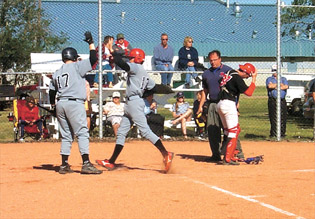 Trevor Chopek crosses the home plate for the Provost bantams baseball team and receives a high five from a team-mate on Saturday morning as the Veteran team was in the field. Meanwhile the umpire watches carefully that the plate is actually touched (right) while the catcher looks for his mask after a missed ball in the field. Midgets, bantams and pee wees baseball teams were busy at the fairgrounds June 28 and 29 in their quests to advance towards provincial baseball finals. ©Provost News Photo. Trevor Chopek crosses the home plate for the Provost bantams baseball team and receives a high five from a team-mate on Saturday morning as the Veteran team was in the field. Meanwhile the umpire watches carefully that the plate is actually touched (right) while the catcher looks for his mask after a missed ball in the field. Midgets, bantams and pee wees baseball teams were busy at the fairgrounds June 28 and 29 in their quests to advance towards provincial baseball finals. ©Provost News Photo.
Print version in July 2 edition of The News.
Want to Subscribe to The Provost News? Click here.
|
Chamber Members Hear of Tourism Potential
• Form Local Group, Set Goal Now, Suggests Archeologist
Members and guests of the Provost and District Chamber of Commerce heard about the possibility of an increase in tourism if local people promoted an archeological dig at Bodo with some type of interpretative centre.
Dr. Terry Gibson along with Beth May were guests at the chamber meeting Wednesday night.
They and a team of University of Alberta archeology students are now mapping a huge find south and west of Bodo that contains bison bones, arrow points and pieces of pottery (see PN June 18).
After a half hour slide show that Gibson prepared he answered questions. He also told local residents that there is a lot of work to be done before an interpretive centre is built—but he encouraged the concept and suggested that a committee be formed to start work on that goal. He said that walking trails could also be established in the area and that winter camps could be offered for those into type of extreme sports. “The more primitive it is, the better for some.”
A local committee could get direction from him and the archeologist noted that landowners in the area should also be brought on-side for such a project. The landowners have “been very co-operative” with Gibson. Much of the land in question is owned by the Crown.
|
The archeologist and anthropologist said that “You can build up to a world class facility” but cautioned that government would not likely be initially involved as was done many years ago at such places as Head-Smashed-In Buffalo Jump (designated as a UNESCO World Heritage Site in 1981), 18 km north and west of Fort Macleod, Alberta, and the Royal Tyrrell Museum near Drumheller. He said that the Bodo project will have to be developed from the “ground-up” instead of being driven by the government. The local oil industry could “probably be persuaded to greatly contribute” to this project.
An oil pool appears to be sitting “about dead centre” on the dig site. Murphy Oil is co-operating with the province being careful not to destroy artifacts and needs Alberta’s permission before pipeline and other work is done in that area. Gibson is also involved with those negotiations. “We aren’t out to stop (oil) development” but archeologists want to protect what’s left. “You have to work closely with industry.”
He pointed out that there should be a goal of having something initially in place for tourists to visit by the year 2005—Alberta’s centennial in confederation. With a project like that there could be provincial money available because of the centennial project if proper application was made. The province would likely put in money—but would not take control of such a project.
As far as the site is concerned “You could spend centuries digging here. There’s just so much in there” Gibson said, referring to the richness of the undisturbed—and vast site that he discovered in 1995.
One of the students is currently doing research there involving interviewing local people and visiting old cemeteries to try to piece together some of the history of the area. “The U of A wants to maintain a strong presence” at the Bodo dig.
Some items found are hundreds of years old while other objects are several thousands of years old.
An interpretative site could include not just bison history but might also weave together a story and artifacts from native tribes and what they were doing at this area. It appears that several different tribes used the area to confine bison and then kill them. May and Gibson believe that ancestors of Blackfoot, Assiniboine and Cree people could have all lived and hunted in the area over the centuries. Evidence of ancient camping has been found at the Bodo site that may indicate that it was also used in the winters.
“There’s tons of stuff out there that hasn’t been disturbed.” In fact, Gibson told his audience, at some places there are more artifacts than dirt discovered in a bucket when it is screened.
The Bodo archeological locality (a collection of sites) is largely undisturbed so archeologists and students are finding it very interesting. By comparison “tens of thousands of sites have been disturbed in Alberta” but the Bodo site has not.
When the Europeans arrived in North America. there were an estimated 60 million buffalo roaming the Great Plains.
Rest of story in July 2 edition of The Provost News.
Want to Subscribe to The Provost News? Click here.
|

|